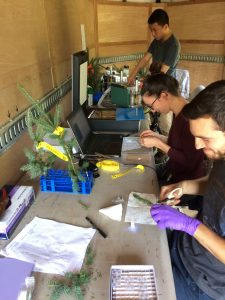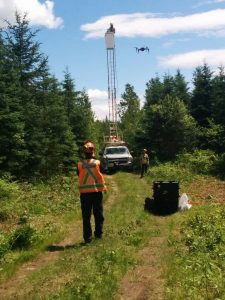Tree breeding programs, carbon accounting models, and biodiversity conservation practices heavily rely on our ability to assess and understand how trees respond to past and current climate, because it allows to predict the fate of trees in the future. Assessing and understanding tree responses to changing climate requires accurate evaluation of the relationship between genotypes, phenotypes and the growth environment.
Association studies between genotypes and environment using previously available genomic approaches have been limited because the list of functional traits to study individual tree responses to climate was rather limited and most of these traits were punctual, complex or burdensome to evaluate. A new generation of association analyses will take advantage of the genotyping efforts of the SMarTForests project (www.smartforests.ca) and of phenotyping for new classes of functional traits generated in this activity.
We are developing innovative phenotyping tools (precision phenotyping) and methods that will help bridge the current gaps in establishing the relationships between genotypes and environment. This will allow identifying candidate genes and gene networks for traits related to resilience to abiotic stress under various soil conditions especially marginal lands. We will also use a novel retrospective approach to ascertain white spruce sensitivity to climate fluctuations along its lifespan in order to determine its pre-existing adaptive capacity to climate changes and fluctuations. We will also deliver biomarkers and genomic selection systems for improvement of abiotic stress resilience.


Photosynthesis fieldwork: drone during flight at St.Casimir, Québec (photo taken by P. D’Odorico)
Working with our End-User partners Natural Resources Canada (NRCan) and Ministère des Forêts, de la Faune et des Parcs du Québec (MFFPQ), we will develop new phenotyping methods and biochemical phenotype proxies for nutrient use efficiency (NUE) and drought resistance, resulting in potent markers for spruce breeding purposes. In doing so, we will develop cost-effective, high-throughput precision phenotyping tools using optical sensors carried by small and inexpensive unmanned airplane vehicles (UAVs, i.e. drones) for operational use by tree breeders and nurseries. Ultimately, phenotypic trait data and quantitative genetics parameters will be delivered to the partner End-Users, as well as genomic selection systems for NUE and drought resistance.
Objectives
- Deliver new methods and tools to monitor spruces in terms of water-use-efficiency and NUE, from the seedling to the adult stage, and better predict resilience to climate anomalies such as drought. New precision phenotyping methods implicating modern imaging and physiological measurement technologies will permit to assess and better understand the architecture of complex traits and rapidly phenotype large numbers of plots and field trials.
- Develop with our partner End-Users NRCan and MFFPQ cost-effective biomarkers and genomic selection systems for drought resistance and nutrient use efficiency in white spruce.